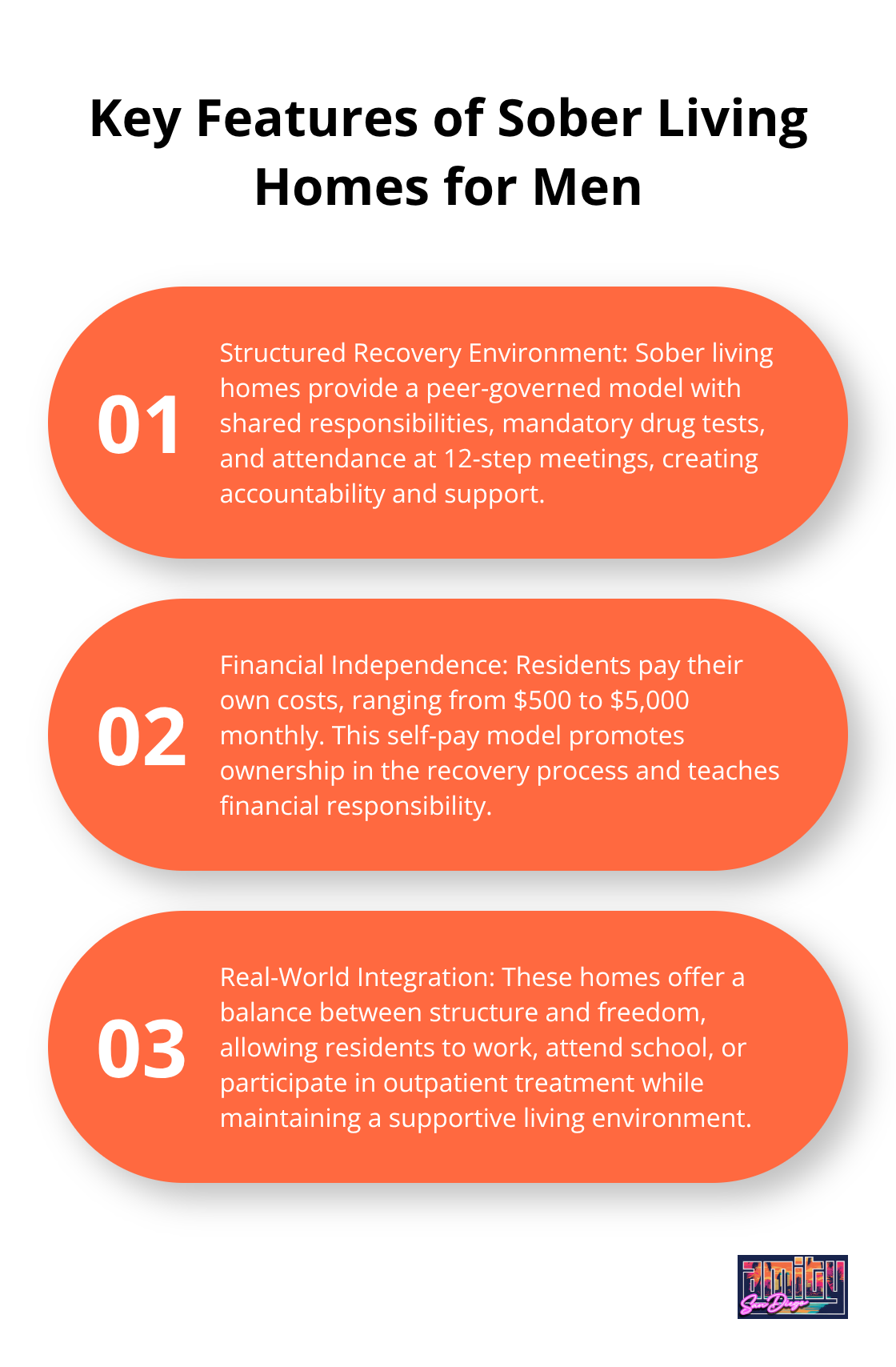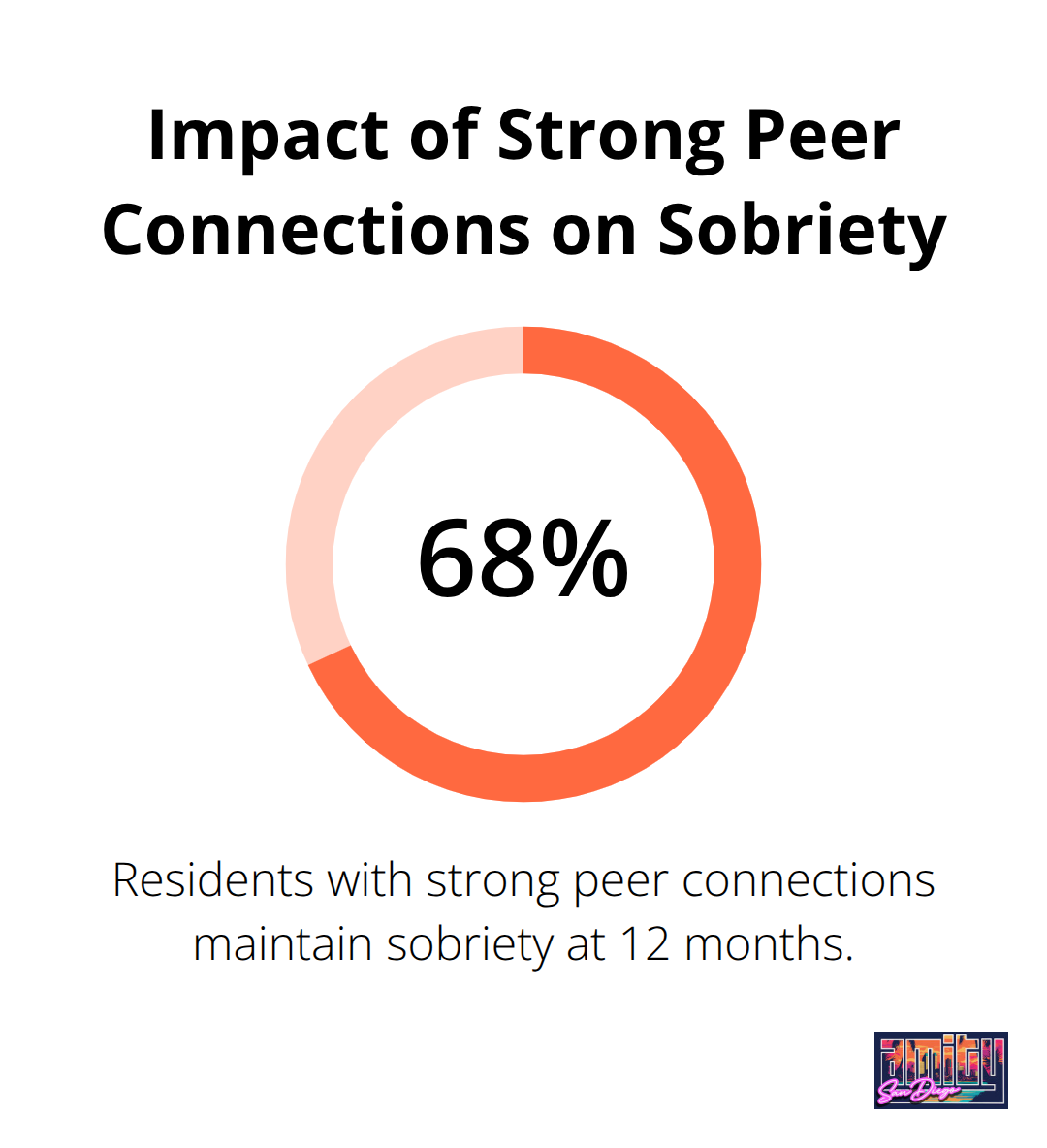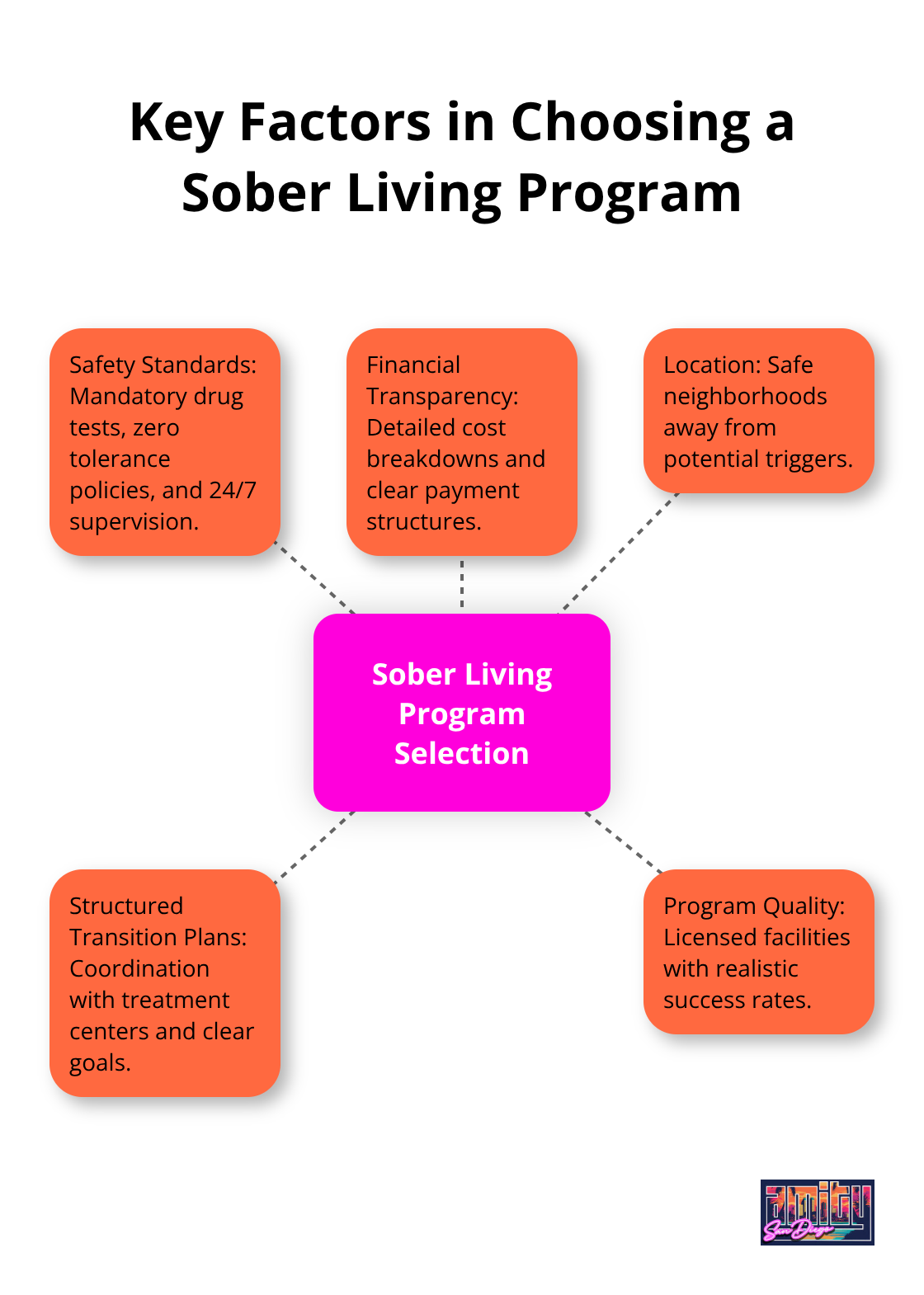Men face unique challenges during addiction recovery that require specialized support and understanding. Traditional mixed-gender environments often create distractions that can hinder progress.
Sober living for men provides a focused environment where residents can build genuine connections with peers who share similar experiences. We at Amity San Diego have seen how male-only programs create stronger foundations for long-term sobriety and personal growth.
How Do Sober Living Homes Work for Men
The Foundation of Structured Recovery
Sober living homes operate as structured, alcohol and drug-free residential environments where men rebuild their lives after they complete initial treatment. These homes function on a peer-governed model where residents share responsibilities like meal preparation, house maintenance, and rule enforcement. Most facilities require random drug tests, mandatory attendance at 12-step meetings, and strict adherence to curfews.
Research by Polcin demonstrates the effectiveness of this approach. Residents who stayed an average of extended periods showed significant improvements in abstinence rates. The structured nature creates accountability partnerships between residents, with house managers who oversee compliance and provide guidance when needed.
Financial Structure and Independence
Unlike traditional halfway houses that receive government funds, residents pay their own costs (which range from $500 to $5,000 monthly depending on location and services). This payment structure creates ownership and investment in the recovery process. Residents must maintain employment or attend school, which teaches financial responsibility while they rebuild their lives.

The self-pay model also means residents have more freedom to choose their living situation based on their specific needs and budget constraints. Many residents use government assistance programs or family support to cover costs during their stay.
What Makes Men-Only Programs Different
Male-specific sober living environments address issues that mixed-gender facilities cannot tackle effectively. Men face unique recovery challenges including suppressed emotional expression, career pressures, and societal expectations around masculinity. Gender-specific programs allow for open discussions about fatherhood responsibilities, relationship patterns, and masculine identity without the social dynamics that co-ed environments create.
Research shows that men in same-gender recovery settings experience positive outcomes in their recovery journey. These programs also implement conflict resolution methods specifically designed for male communication styles, which help residents manage disagreements constructively rather than through confrontation or withdrawal.
Structure That Promotes Real-World Success
Sober living homes provide more freedom than residential treatment centers while they maintain stricter boundaries than independent living arrangements. Residents can work full-time jobs, attend school, or participate in outpatient treatment programs during the day, then return to a supportive environment each evening. This balance teaches men how to navigate real-world responsibilities while they maintain sobriety.
Treatment professionals recommend at least 90 days in structured recovery environments, as recovery is highly individual and requires adequate time for lasting change. This extended timeframe allows residents to establish employment stability, rebuild family relationships, and develop coping mechanisms that prevent relapse. For those seeking comprehensive addiction treatment San Diego offers specialized programs that complement sober living arrangements. The next consideration involves understanding the specific benefits that male-only environments provide for sustained recovery success.
Why Male-Only Environments Transform Recovery
Romantic Distractions Disappear and Progress Accelerates
Male-only sober living environments eliminate romantic complications that consistently derail recovery progress in mixed-gender settings. Research from the Journal of Psychoactive Drugs shows that residents in single-gender homes report fewer interpersonal conflicts compared to co-ed facilities. Men focus entirely on rebuilding their lives without navigating dating pressures, relationship drama, or sexual tension that often leads to relapse triggers.
The absence of romantic distractions allows residents to form authentic friendships based on mutual recovery goals rather than romantic interest. This creates a foundation for honest communication about addiction struggles, family problems, and career setbacks without the posturing that occurs when men try to impress potential partners.
Brotherhood Networks Create Unbreakable Accountability
Men in recovery develop powerful peer support systems that function like brotherhood networks. Studies by Polcin show that residents who form strong peer connections maintain sobriety rates of 68% at 12 months, compared to lower rates for those with weaker social bonds. These relationships create natural accountability where house members monitor each other’s behavior, attendance at meetings, and emotional well-being.

The brotherhood model works because men communicate differently about personal struggles when women are not present. They share experiences about job stress, financial pressures, and family responsibilities more openly, which creates support networks that extend beyond the sober living period. Residents develop conflict resolution skills specifically tailored to male communication patterns and learn to address disagreements directly rather than through passive aggression or withdrawal.
Male-Specific Mental Health Issues Get Direct Treatment
Men face unique addiction triggers including suppressed emotional expression, career performance anxiety, and societal expectations around providing for families. Male-only programs tackle these issues head-on through group discussions about masculine identity, fatherhood responsibilities, and workplace stress management. Men often struggle with emotional suppression, making gender-specific therapy approaches essential for lasting recovery success.
These specialized environments address the reality that men often struggle with vulnerability and emotional openness in mixed-gender settings. House meetings focus on topics like anger management, financial stress, and relationship patterns that specifically affect men in recovery. For those seeking comprehensive support, addiction treatment San Diego offers specialized programs that complement sober living environments. The structured approach to selecting the right sober living program becomes the next critical step in this recovery journey.
How to Select the Right Sober Living Program
Non-Negotiable Safety Standards Matter Most
Quality sober living homes implement mandatory drug tests with zero tolerance for positive results. Research shows that facilities with strict requirements achieve better outcomes, with staying at least six months in sober living houses related to better outcomes than leaving earlier. Look for homes that conduct random screens at least twice weekly and require immediate departure for violations. The best programs also maintain 24/7 supervision with trained house managers who monitor compliance and provide crisis intervention when needed.
Safety extends beyond drug tests to neighborhood selection. Avoid homes located near bars, liquor stores, or known drug activity areas. The Substance Abuse and Mental Health Services Administration emphasizes that environmental factors directly impact recovery success rates. Homes in residential neighborhoods with low crime statistics create fewer triggers and support long-term sobriety goals.
Financial Transparency Reveals Program Quality
Legitimate sober living programs provide detailed cost breakdowns that include rent, utilities, food, and additional services. Monthly fees typically range from $500 to $5,000 based on location and amenities, but beware of programs that promise unrealistic success rates or lack proper licenses. Ask for specific documentation about insurance coverage limitations, as most insurance plans do not cover sober living costs since these facilities are not classified as medical treatment centers.
Programs that require upfront payments for extended periods often operate as scams. Quality homes collect monthly rent and security deposits only, which allows residents flexibility to leave if the environment does not meet their recovery needs. Employment requirements should be clearly stated, with most reputable programs that expect residents to maintain jobs or attend school within 30 days of admission.

Structured Transition Plans Prevent Relapse
The most effective sober living programs coordinate directly with treatment centers to create seamless transitions from residential care. This includes medication management continuity, therapy schedules, and 12-step connections in the local community. Programs should provide written transition plans that outline specific goals, timelines, and accountability measures for the first 90 days of residence (which research shows are the most vulnerable period for relapse).
For comprehensive support throughout your recovery journey, consider exploring professional addiction treatment San Diego options that can complement your sober living experience.
Final Thoughts
Sober living for men creates the structured environment necessary for sustainable recovery success. Research demonstrates that men who complete extended stays in gender-specific programs achieve abstinence rates of 68% at 12 months, significantly higher than mixed-gender alternatives. The elimination of romantic distractions, combined with brotherhood accountability systems, allows residents to focus entirely on rebuilding their lives.
The key factors for success include selecting programs with mandatory drug testing, qualified supervision, and safe neighborhood locations. Financial transparency and structured transition plans separate quality facilities from substandard options. Men benefit most from environments that address masculine identity challenges, emotional expression difficulties, and career pressures through specialized programming.
Recovery requires comprehensive support beyond sober living arrangements (which provide the foundation but not complete treatment). We at Amity San Diego provide evidence-based addiction treatment San Diego that complements residential recovery programs. The combination of structured sober living for men and professional treatment creates the strongest foundation for long-term sobriety and personal growth.

